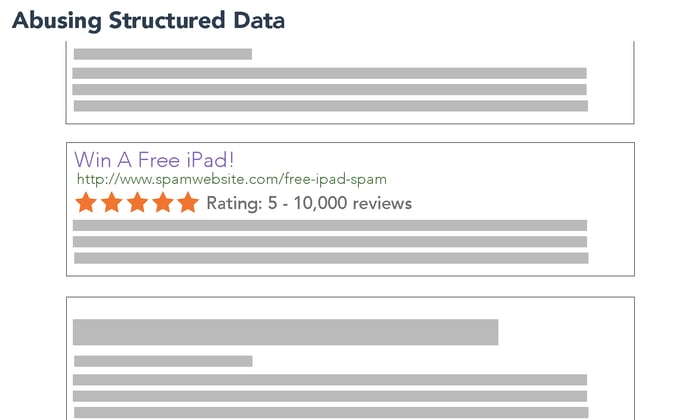If you are new to the search space, the purpose of search engines like Google is to provide the best results when someone completes a search. They want people to have a great search experience and ensure the results they provide do not include spam. They do this automatically through algorithms or manual actions that aim to recognize and penalize those engaging in black hat SEO.
Search engine algorithms have gotten more sophisticated over time, which is why you should avoid black hat SEO at all costs. White hat SEO is a much better method of doing search engine optimization. It’s a more ethical approach that abides by the terms and guidelines set out by search engines. White hat SEO consists of creating quality content and a better overall user experience for people visiting your site.
Black Hat SEO vs. White Hat SEO
Black hat SEO goes against the guidelines set by search engines and manipulates them to gain higher rankings. It can lead to being wiped completely from search results or gaining a lower position. White hat SEO is a more ethical way of doing SEO by creating quality content and a good user experience.
This article will explain what black hat SEO techniques involve so you can make sure to avoid them when devising your organic search strategy.
Black Hat Techniques in SEO
Keyword Stuffing
Keyword stuffing refers to the practice of filling your content with irrelevant keywords in an attempt to manipulate where the page ranks on search results pages. Adding multiple variations of keywords where they add no value creates a bad experience for users. It may also cause your page to rank for irrelevant queries.
Google explains keyword stuffing as:
- Lists of phone numbers without substantial added value.
- Blocks of text listing cities and states a web page is trying to rank for
- Repeating the same words or phrases so often that it sounds unnatural.
Here’s an example of keyword stuffing for a website selling outbound marketing software:
“We are in the business of selling outbound marketing software. Outbound marketing software is what we sell. If you are thinking of getting outbound marketing software get in touch with one of our outbound marketing software consultants.”
I think you’ll agree, that sounds like a broken record. It’s pretty easy to spot and Google will be able to tell that the content sounds unnatural.
You may have heard the joke “an SEO copywriter walks into a bar, grill, pub, public house, Irish, bartender, drinks, beer, wine, liquor…”. This joke is about keyword stuffing and it is another perfect example of the practice. The words are all similar to each other, but they are of no value as they don’t even string up a sentence.
You can do keyword research to find out what people are searching for but overusing these keywords in your content is not a good idea. Rather than filling your content with irrelevant keywords, concentrate on creating useful content that focuses on topics over keywords.
Cloaking
Cloaking involves showing one piece of content to users and a different piece of content to search engines. Websites practicing black hat SEO will do this in order to make content rank for a variety of terms irrelevant to their content. Spam websites will often do this to try and avoid a search engine bot finding out the spam content they serve to users.
Tailoring your content to different groups of users is acceptable. For example, you might shrink the size of your website when someone visits from a mobile device. You might also change the language of a page based on the country someone is visiting from. A publisher like Forbes or Inc might change the ads that appear on a page in order to fund their content. These examples are completely acceptable. As long as you are not just changing the content that appears for search engine crawlers.
While there is no hard and fast rule to determine what's acceptable and what’s not, my best advice is to ask yourself, does what you intend to do solve for the user? If it does, then it’s acceptable. You should treat search engine bots that crawl your site the same as any other user.
If you are curious to find out how Google sees your website you can use the fetch as Google tool and compare this to what users see.
Sneaky Redirects
A redirect involves sending someone to a different URL than the one they initially clicked. Black hat SEO uses redirects outside of the purpose they are intended for. Along the same lines as cloaking, this might include redirecting a search engine crawler to one page and all other users to another page.
Another example is redirecting a highly authoritative page with lots of backlinks into another irrelevant page, just to boost its position in search results. A 301 redirect passes the majority of authority from one page to another. This means someone practicing black hat SEO could use redirects solely for the purpose of manipulating search results.
Redirects should only be used for the purpose they were designed. This might be in the event you change website domain or consolidate two pieces of content. It’s also acceptable to use JavaScript to redirect users on some occasions. Take for example, LinkedIn redirecting you to someone's full profile when you are logged in, rather than show you the public version of a users profile when you are logged out. Sneaky redirects, on the other hand, should be avoided. They violate the guidelines of search engines such as Google.
Poor Quality Content
Poor quality content that’s of no value to the searcher is also a common practice in black hat SEO. This includes content scraped from another website either by a bot or a person. At one point search engines like Google weren’t good at recognizing content that had been copied from other websites. The Google Panda update in 2011 resolved this issue. Many sites with duplicate content took an instant hit in search rankings. Since then, Google has gotten much better at recognizing duplicate and low-quality content.
Adding invisible keywords to your content is also a prohibited practice. Some websites that engage in black hat SEO do this by making the text the same color as the page background. This means the page may appear in search results for those invisible keywords, even though there’s no visible content about them on the page. When a user clicks on the result thinking it’s going to be about the topic they searched for, they don’t find any of the content they were looking for as the keywords are invisible. If you’re solving for the user, there should be no need to hide content on your website.
The “bait and switch” is another black hat means of misleading search engines. This involves creating content surrounding a topic you want to rank for. Once the page is ranking in results for this topic, the content is swapped out for something else. This creates a negative experience for searchers as the content they click-through to see no longer exists. These practices trick users and search engines and they are not a good way to do SEO.
Writing original, quality content is an important part of white hat SEO. Not only is it required to avoid a penalty from search engines, it will also set your website apart. Creating high-quality content builds trust with your target audience and turns visitors into customers.
Paid Links
Search engines like Google strictly ban the buying and selling of links. They state on their website that “any links intended to manipulate PageRank or a site's ranking in Google search results may be considered part of a link scheme and a violation of Google’s Webmaster Guidelines.” This includes sending a website free products in exchange for links. If you’re not sure of what’s an acceptable exchange, Matt Cutts, the former head of Google’s webspam team recommends looking at FTC guidelines.
You should avoid paying any other site to link to your content. Google asks users to tell them about instances of people buying or selling links. They state they will penalize both buyer and seller of links once the practice is detected.
If you’re reading this having purchased links without realizing this is a black hat SEO tactic, you should have them removed as soon as possible. You can also use the disavow links tool if you can’t get webmasters to remove the links.This tells Google to disregard the paid links when calculating your Pagerank.
Abusing Structured Data/Rich Snippets
Structured data is also known as rich snippets and schema. It allows you to change how your content is displayed on search engine results pages. It makes your content stand out from competitors and also gives you more real estate on results pages. You can add structured data to a page displaying a podcast, recipe, book among other products and services. Reviews schema markup is probably one of the most popular types of structured data.
Black hat SEO involves providing inaccurate information in structured data to fool search engines and users. For example, someone practicing blackhat SEO might award themselves five stars from a fake review site and add structured data so they stand out on search results pages. This is a very risky practice as search engines like Google encourage users to report websites misusing structured data.

This should not put you off marking up truthful, accurate information on your web pages. In fact, I highly recommend adding structured data the white hat way. We added review markup to HubSpot product pages and saw a 10% increase in clicks to those pages.
You have nothing to worry about, if you provide truthful information that is helpful to users. Google has documented the rules around adding structured data to your website and also have a helpful tool for testing your structured data.
Blog Comment Spam
As the name suggests, this black hat technique involves including a link to your website in blog comments. This practice happens less often nowadays as search engines like Google updated their algorithm to discount any links in blog comments. Most authoritative blogs now make links in blog comments nofollow by default. This means search engines like Google do not follow the link nor does it the link pass any authority.
Despite the decline in the number of people engaging in the practice, you’ll still find a bunch of people on Fiverr advertising blog commenting services. Blog commenting, with links to your website is a spammy way of getting links to your website and we highly recommend avoiding the practice.
If you own a publication, forum or community that allows comments you need to take care to ensure that your comments section can’t be spammed by either bots or people. Search engines like Google will demote or completely remove pages containing spam from the search results. Using anti-spam tools like Google’s free reCAPTCHA tool is one way to mitigate the risk of spam user generated content.
Link Farms
A link farm is a website or a collection of websites developed solely for the purpose of link building. Each website links out to the site or sites they want to rank higher on search engines. Search engines rank websites by looking at the number of links that point to the website, among other factors. Black hat SEO exploits this by using link farms to inflate the number of backlinks a particular site has.
Link farms often have low-quality content and lots of links. The links normally contain the keyword they want the site to rank for in the anchor text. Search engines like Google can easily detect link farms and using them should be avoided. Instead, you should use white hat SEO tactics like creating amazing content, graphs, data, interviews or any other content that allows you to acquire backlinks naturally over time.
Private Blog Networks
A private blog network (PBN) is a bunch of authoritative websites used solely for link building. They are similar to link farms in that they both aim to exaggerate the number of links pointing to a website. Each PBN site links to the site they want to boost in the search results but do not link to each other.

Black Hat SEOs wanting to build a private network will normally buy expired domains that have already built up authority. They’ll write content similar to what already existed on the domain before it expired and add links to their own site. They hope that search engines won’t notice they’re controlling a network of websites and rank their main website mucher higher in the search results.
Search engines have gotten clever at spotting PBNs and your site could be hit with a severe penalty if you are using PBNs to improve your search presence. Rather than put effort into spinning up fake websites focus on creating quality content under your own domain. Keeping your content under one roof means your site will be highly authoritative as everyone will link to the one domain.
Examples of Black Hat SEO
Groupon’s Bait and Switch
Groupon was accused of doing a bait and switch by San Francisco Comprehensive Tours. The tour company ran a one of promotion with Groupon but the voucher website continued to advertise the promotion on Google long after it had ended. When searchers clicked on Groupon’s page there was no discount to be found as the content had been swapped out. This bait and switch happened in a PPC advertisement but they often happen on organic results too.
J.C. Penney’s Black Hat Links
J.C. Penney ranked at the top of search results for a vast number of keywords from “skinny jeans” to “home decor”. The retailer’s exceptional performance in search results was perfectly timed around the holiday season. This outstanding performance in search results was thanks to black hat SEO link building techniques that slipped under Google’s radar.
Just over 2,000 backlinks were discovered by Doug Pierce. These links contained anchor text with the very keywords J.C. Penney wanted to rank for on search engines. Many of the links were found on websites of no relevance to J.C. Penney. The topics of these websites ranged from casinos to cars. J.C. Penney claimed no responsibility for the links that were found in an interview with the New York Times.
Google confirmed the actions of J.C. Penney went against their webmaster guidelines and revealed that they also had violated webmaster guidelines on three previous occasions. J.C. Penney received a Google penalty that saw them drop down close to seventy positions on Google for terms such as “living room furniture.”
Sprint’s User Generated Spam
In 2013 a user called Redleg x3 posted on Google’s Webmaster Central forum explaining Sprint got a notification from Google warning of user-generated spam on their website. Google’s Matt Cutts commented on the thread saying he could see the majority of spam had been removed from the website. He explained the company should “...try to catch the spam a little faster or see if there are some ways to make it a bit harder for the spammers to post a large amount of messages on the community pages.”
Forbes Selling Links
Someone appearing to be from Forbes posted on the Google Webmaster Central forum seeking help with a link violation notice. The notice asked Forbes to remove unnatural links from their site’s content.
Google’s Matt Cutts commented in the thread that he had confirmed multiple times that paid links that pass PageRank. Cutts recommended that Forbes remove the paid links that pass PageRank to have the penalty reversed. TechCrunch reported that Forbes began to remove the paid links back in 2011 after receiving the penalty.
Google Chrome’s Paid Link
Even Google messes up their own SEO from time to time. On one occasion they included a follow link in a sponsored post about Google Chrome. This falls under black hat SEO as the link was included as part of sponsored content that was paid for by the company. The Google webspam team applied a penalty to www.google.com/chrome, reducing its Pagerank for a period of sixty days. The black mark against Google Chrome caused them to drop in position on search results for the term “browser”.
Why You Should Avoid Black Hat SEO
While black hat SEO is not illegal, it does violate webmaster guidelines set out by search engines. In other words, it’s still against the rules. This means if you engage in black hat SEO, you must be willing to get hit with a nasty penalty as punishment. Getting a penalty from search engines will cause your website to drop down in the search results or worse, it could be removed completely. This means your website will gain less traffic and ultimately, fewer customers.
Search engines have gotten better and better at spotting black hat SEO techniques. Nowadays getting caught for practicing black hat SEO is pretty much unavoidable. Black hat SEO does not solve for the searcher nor does it solve for the search engine. While you may see short-term gains from black hat SEO over time search engines will pick up on your black hat ways damaging your presence in search.
The Blurred Lines of Grey Hat SEO
You won’t find grey hat SEO in the middle of a Robin Thicke song, but you will find it somewhere in the middle of black and white hat SEO. If there’s an SEO tactic you find hard to categorize as black or white hat SEO, then it’s probably a grey hat technique.
What is Grey Hat SEO?
Grey hat SEO consists of slightly shady SEO tactics. While they are not against search engines prohibited practices, they are slightly unethical and could be banned in the future.
Grey hat SEO threads close to the line of black hat SEO. Grey hat tactics are normally not listed in webmaster guidelines as prohibited practices but they are a little dubious. Many grey hat practices have become black hat practices over time, once search engines found out about them.
How To Avoid Black Hat SEO
There’s no doubt black hat SEO is a risky business that’s not worth engaging in. Here are best practices to avoid black hat SEO:
- Treat the searcher and search engines the same way. Avoid “cloaking” or tricking search engine crawlers by redirecting them to another page. You should always focus your efforts on solving for the searcher and create a great user experience from search engine to site.
- Write only good quality original content that avoids keyword stuffing. Never scrape, duplicate or reword content that belongs to others. Google’s content guidelines and our content creation kit may be helpful.
- Abide by the rules when adding structured data to your website. Ensure any schema markup you add is accurate and not misleading to users.
- Never buy or sell links and remember, it’s not just money that’s considered a black hat exchange. Providing free products in exchange for links is also prohibited. If you are unsure if an exchange might be unethical lean on the FTC endorsement guidelines and consult this detailed blog post about paid links from Google.
- Avoid setting up a private blog network for the purpose of getting links. Differentiate your website and content so people link to you naturally rather than fake it till you make it. That never ends well.
- Stay up to date on webmaster guidelines so you can avoid black hat tactics prohibited by search engines. Here are the webmaster guidelines for Google and Yahoo.
Don’t make your next search “how do I get rid of a Google penalty?” If you need to question whether something is black hat or not, it probably is. A white hat SEO strategy is a much better approach to search engine optimization. In the long run, it will pay dividends and you can sleep at night knowing you’ll never see a dip in your rankings due to a nasty penalty. So for the love of search engines, never do black hat SEO. After all, they are the ones that keeping us SEOs in the business.
SEO







.png)




.jpg)